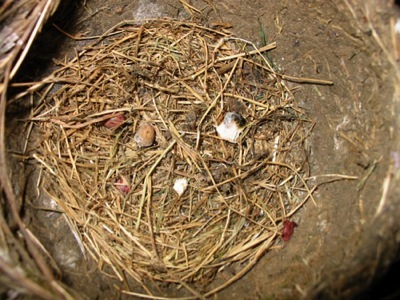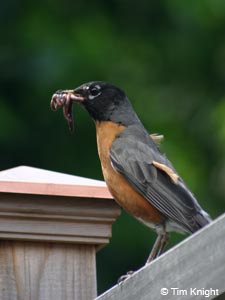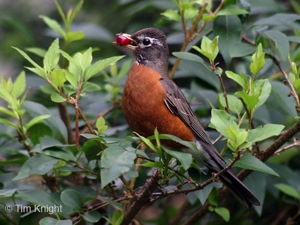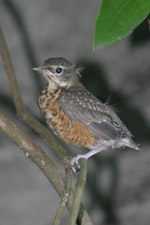


|
American Robin (Turdus migratorius) Nest buildingAmerican Robins pair-bond during the breeding season. Females are primarily Nest location and sizeThe bowl-shaped nests are built in a bush, tree or under the eaves of buildings - 5 to 25 feet off the ground. The nest is 6 inches across and 4 to 6 inches high. The rounded inside area of the nest is about 3.5 to 4 inches in diameter, which is large enough to hold a baseball (see photo below). 
To be successful, the robin nest must last for more that a month, safely hold 4 growing birds and provide insulation from the heat and cold. Think of the nest as a baby incubator with the female robin providing the heat required for the young to develop inside the egg. The female continues to sit on the nest for 10-12 days after all the nestlings hatch. She keeps the nestlings warm, safe and dry. Reusing nestsSometimes the nests are reused. One nest was built on top of a old robin's nest that was constructed three years ago. So, if you find an old bird nest it's a good idea to leave it alone.One creative robin used parts of an old nest for building a sturdy nest under the eave of a house. The female sampled a few locations before deciding to build her nest in a hidden location that was well protected from wind and rain. Nest location is critical in a rainy area like Seattle. The nest included lichens collected from a maple tree and small twigs from a hemlock tree located near the house. The nest building process took about two days to complete. Robin eggs
The female typically lays two to four light blue eggs - about the size and weight of a quarter (see photo). The female incubates the eggs over a two-week period and both parents care for the young. The eggs take around two weeks to hatch and the chicks will fledge when they are about 12 to 14 days old. The female may produce two broods of young each year. The young are born with their eyes shut and first open their eyes around five days after hatching. Protecting the nestBoth parents aggressively defend the nest area. They emit a series of alarm calls that distract predators. When the nestlings hear the alarm call, they duck down low in the nest and remain silent so they to go undetected by predators (including crows). When the female is sitting on the nest she is silent and moves slowly since she doesn't want predators to find the nest. During feeding, the young make chirping sounds but these calls can only be heard a short distance away. Watch Out! Male robins are well known for dive-bombing people and predators within ten feet of a nest. The birds will swoop down close to your head to and call loudly to draw your attention away from the nest site. Keeping the nest clean
The nestlings poop after every feeding - that's a lot of waste! But the nest is very clean, so where does all the waste go? Nestlings produce a "fecal sac" - a white bundle of poop - after each feeding. After the nestling eats a worm, they lift up their rear and excrete the white sac which is collected in the beak of the adult bird. Fecal sacs are like disposable diapers for birds! Sometimes the parent carries the fecal sac away in their beak and drops it far from the nest. Other times the adult swallows the fecal sac at the nest site - yuk. Apparently, the parents may eat the sacs for extra nutrition. The sac is removed from the nest by the parents to keep the nest clean. This behavior helps to reduce exposure to pathogens and parasites, or odors that can lead to predation.
   Photos of American Robin male, female and juvenile. Source: This information is based on direct observations by Tim Knight of four nest sites in Seattle, Washington. Robin behavior and nesting activity can vary with location. More information: American
Robin Blog - Nesting photos and behavior
Photos © Tim and Henry Knight
|